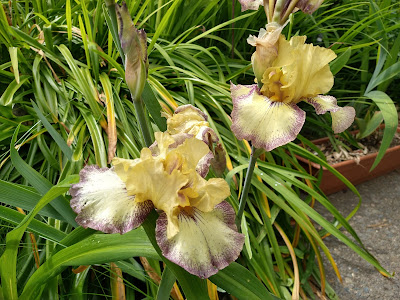
Bearded irises need late-summer rejuvenation to keep blooming

|
|
These are Tennessee Gentleman irises. Divide and
replant irises every three to five years for best
production. (Photo: Debbie Arrington)
|
Have your bearded irises stopped blooming? When was the last time you dug them up?
Every three to five years, bearded irises need to be dug up and started over. That’s the key to their durability and consistent bloom.
Each thumb-like growth on the rhizome – the plant’s fleshy underground stem – only flowers once. The rhizome then grows and produces another thumb, which will bloom the next year. But if the rhizomes run out of room to grow, they stop blooming.
Timing is everything with this chore; irises need to be divided and replanted in late August or September to get ready for spring bloom. So, now is the right time to dig up the iris bed.
Why grow irises? They’re among the best water-wise perennials for the greater Sacramento area. They’re low maintenance, drought tolerant and reliable. Deer won’t eat them and most pests leave them alone. They pretty much take care of themselves most of the year, dying back in fall before re-emerging for a massive spring flower show.
What you see above ground is tied directly to what’s below ground. Over time, iris rhizomes lose their vitality. They rot or wither away. Side shoots grow from the central rhizome to form new baby rhizomes. It’s those baby rhizomes that will produce the future blooms.
Fans of leaves sprout from the tips of those thumbs. Since those thumbs can bloom only once, discard any segments attached to flower stalks when dividing iris.
How do you know which to keep, which to cut? Dig up the rhizomes and look.
Shallow-rooted, they come up very easily, pried from the ground with a pitch fork or spade.
Once they're unearthed, wash the rhizomes off with water and start working them apart, using your fingers and a trowel or sharp knife. Keep the young healthy rhizomes with one or two fans of leaves and healthy roots attached. Break off the aged, bloomed-out, rotted or dried-out pieces and discard. Also look for insect damage; cut that out, too. Of the fans you keep, trim the leaves down to 4 to 6 inches.
Now you’re ready to replant. Rejuvenate the planting area with some well-aged compost and a little bone meal, worked into the top 6 inches of soil. (That’s going to be all the fertilizer the irises need for the next three to five years.)
Plant the rhizomes about 12 inches apart so the fan of leaves sits right on the soil surface, with the rhizome just under the soil. The rhizome will grow in the direction the fan is facing (with the curve of leaves to the outside); position plants accordingly so they have room to spread and sprout new flower stalks.
Unlike most perennials, don’t cover with mulch. (That can promote rhizome rot.) Water deeply once, then let rest.
Want to learn more about irises? Check out the Sacramento Iris Society: https://sacramentoirissocietydotcom.wordpress.com/
Comments
0 comments have been posted.Sacramento Digs Gardening to your inbox.
Sites We Like
Garden Checklist for week of April 21
This week there’s plenty to keep gardeners busy. With no rain in the immediate forecast, remember to irrigate any new transplants.
* Weed, weed, weed! Get them before they flower and go to seed.
* April is the last chance to plant citrus trees such as dwarf orange, lemon and kumquat. These trees also look good in landscaping and provide fresh fruit in winter.
* Smell orange blossoms? Feed citrus trees with a low dose of balanced fertilizer (such as 10-10-10) during bloom to help set fruit. Keep an eye out for ants.
* Apply slow-release fertilizer to the lawn.
* Thoroughly clean debris from the bottom of outdoor ponds or fountains.
* Spring brings a flush of rapid growth, and that means your garden is really hungry. Feed shrubs and trees with a slow-release fertilizer. Or mulch with a 1-inch layer of compost.
* Azaleas and camellias looking a little yellow? If leaves are turning yellow between the veins, give them a boost with chelated iron.
* Trim dead flowers but not leaves from spring-flowering bulbs such as daffodils and tulips. Those leaves gather energy to create next year's flowers. Also, give the bulbs a fertilizer boost after bloom.
* Pinch chrysanthemums back to 12 inches for fall flowers. Cut old stems to the ground.
* Mulch around plants to conserve moisture and control weeds.
* From seed, plant beans, beets, cantaloupes, carrots, corn, cucumbers, melons, radishes and squash.
* Plant onion sets.
* In the flower garden, plant seeds for asters, cosmos, celosia, marigolds, salvia, sunflowers and zinnias.
* Transplant petunias, zinnias, geraniums and other summer bloomers.
* Plant perennials and dahlia tubers for summer bloom.
* Mid to late April is about the last chance to plant summer bulbs, such as gladiolus and tuberous begonias.
* Transplant lettuce seedlings. Choose varieties that mature quickly such as loose leaf.